To bring online its most promising deepwater province, Petrobras is employing a management model designed for integrated and harmonious planning and execution.
Jose Formigli, Mauro Yuji Hayashi, Fernando Mauricio de Aquino Mendes and Mariana de Souza Muniz Pinto, Petrobras; and Michèlle Correia Sampaio, Deloitte Consulting
Petrobras has designated a team to build its Master Plan for Santos Basin’s Pre-Salt Cluster Development, also known as PLANSAL, a guide to the exploration and production of oil and gas of this new frontier. At this point, Petrobras is increasing the managerial focus in all technical expertise, as well as encouraging tight integration and teamwork among all people involved. The key characteristics associated with pre-salt, such as relatively low exploratory risk, relevant volume discoveries even in the early phase of exploration, and high-productivity reservoirs associated with an environment of intensive technical and managerial interaction, allow Petrobras to adopt bold and challenging strategies for development of the area.
BACKGROUND
Over its 56 years of existence, Petrobras has undertaken many challenges. To explore and produce the petroleum accumulations under the salt layer might be one of the biggest of them all. It was only some 10 years ago that the decisions were made that are now expected to more than double the company’s offshore production. After the opening of Brazil’s E&P sector to private companies under the Petroleum Law of 1997, yearly rounds of bids for exploration acreage took place. With more international oil companies coming to Brazil in 2000 and 2001 to seek opportunities in the second and third bid rounds, Petrobras acquired licenses for seven large offshore blocks (six of them as operator) in a new portion of the relatively unexplored Santos Basin. This collection of blocks gave origin to what is now being called the “Santos Basin pre-salt cluster,” Table 1.
| TABLE 1. Blocks and consortia in Santos Basin pre-salt cluster |
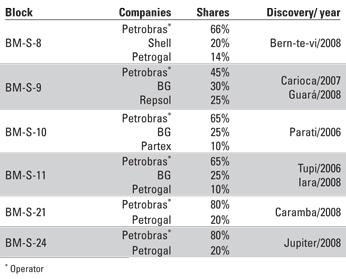 |
Having collected the biggest 3D seismic acquisition of the world up to then, by 2002 and 2003, Petrobras was able to find targets with potential oil-bearing reservoirs. But to make things even more complex than the 300-km distance to shore and water depths up to 2.5 km, those targets were located under a salt layer that could be more than 2 km thick and in reservoir rocks that were unknown, Fig. 1.
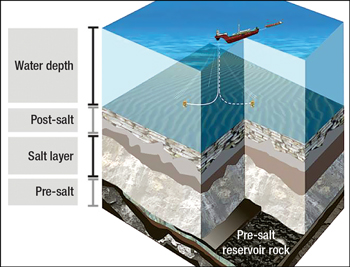 |
|
Fig. 1. Post-salt and pre-salt layers.
|
|
Drilling efforts began in 2005. The very first well drilled that crossed the salt layer, in BM-S-10, had to overcome all kinds of technical problems, and the question of aborting the drilling project was raised. However, these technical problems were overcome one at a time. It took 15 months and US$240 million from spud for Petrobras and its partners to find a field of gas and condensate reservoirs 7,600 m below the ocean surface. This discovery, called Parati, proved the existence of petroleum accumulations under the salt layer. Before that time, all exploratory efforts had targeted the post-salt layer.
This result thrilled the team and reinforced Petrobras’ decision to keep drilling other blocks in the pre-salt area. The next well, in Block BM-S-11, had estimated costs of about $100 million and found light oil before the end of 2006 in a discovery called Tupi.
LOW RISKS BUT STILL A CHALLENGE
After Parati and Tupi and until 2009, Petrobras drilled 41 exploratory wells targeting pre-salt with a success rate of 85% in the pre-salt province that extends from south of the Santos Basin up to the north of the Campos Basin, Fig. 2. This far exceeds the industry benchmark of about 30% for an excellent success rate.
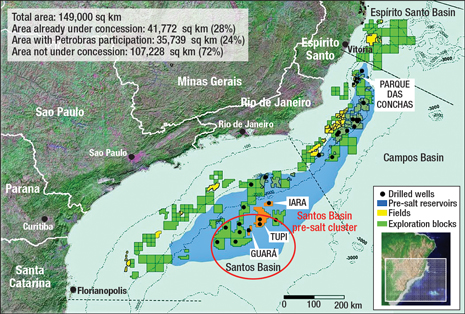 |
|
Fig. 2. Pre-salt province.
|
|
In the Santos Basin, Petrobras experienced a 100% success rate, and preliminary resource estimates suggested accumulations comparable to all the proved reserves ever discovered by the company—some 27 billion boe since 1953, 13 billion boe of which has been produced to date. The company’s remaining proved reserves are 14.17 billion boe. Announced expectations of recoverable volumes for pre-salt fields with only four discoveries indicate a potential of 10.6–16 billion boe from Tupi/BM-S-11 (5–8 billion boe), Iara/BM-S-11 (3–4 billion boe), Guará/BM-S-9 (1.1–2 billion boe) and Espírito Santo’s Parque das Conchas (1.5–2 billion boe). Taking into account the transfer of E&P rights with compensation that the Brazilian government intends to make to the company, pre-salt resources to be incorporated in the years to come may reach an expected upper limit of 21 billion boe, or more than 75% of what has ever been discovered in Brazil.
The Santos Basin pre-salt discoveries all occurred within just four years (2006–2009). The post-salt exploratory process in the central area of the Campos Basin was very different: it took 42 discoveries over 28 years to obtain original volumes of oil and gas in place similar to those that are currently estimated to exist in Santos Basin’s pre-salt. The better visibility of pre-salt potential extension allows for a more integrated and longer-term planning effort and gives rise to an aggressive production and infrastructure deployment strategy.
The Campos Basin reached daily production of 1 million bbl after 27 years, while the Gulf of Mexico achieved it in 24 years and the North Sea in 11 years. The pre-salt has potential to achieve the same level in 12 years.
Despite the high success rate and, consequently, lower exploratory risk, the production development of pre-salt in the Santos Basin would be very different from Campos Basin development, not only because of the geological issues involved but also because of the very high potential volumes of oil and gas expected.
For example, Marlim, the giant Campos Basin post-salt field, has an area of 150 sq km and was developed with seven production units. A similar ratio of production units to area at Tupi (1,974 sq km) would indicate a need for about 90 production units. Basing the comparison on recoverable volumes instead, between 12 and 19 production units would be necessary for only one pre-salt field development. Thus, the development concepts used in the Campos Basin cannot be relied upon for the pre-salt, especially given the unique characteristics of the Tupi area (ultradeep water, remote location, deep reservoirs, contaminants in the producing fluids, higher GOR, etc.).
Even though current forecasts already point to the possibility of exploiting Tupi with much fewer units than predicted above, those simple comparisons demonstrate that this new E&P frontier, even though it has lower exploratory risk than usually accepted by the industry, needs a new and innovative approach to production development to ensure its economic viability.
SANTOS BASIN PRE-SALT STRATEGY
The fact that all six blocks operated by Petrobras were acquired during the same period, are located in the same geographic area, and have similar characteristics allowed Petrobras to build up an integrated strategy for the Santos Basin pre-salt cluster area E&P development to optimize physical and financial resources.
The first step of the integrated planning effort was to dedicate experienced technicians and managers to develop the Master Plan for Santos Basin’s Pre-Salt Cluster Development (PLANSAL), which contains the set of strategies and projects that guide the area’s development from exploration to oil and gas transportation. The first version of this plan was developed in 2008, and its third edition is being elaborated.
After thorough analysis, the company’s executive group concluded that it was better to seek a phased development strategy for the cluster. Such an approach, already a tradition in Petrobras, in four phases would provide the cash flow needed to support subsequent projects and allow for the exploration effort to be carried out parallel to development.
In the short term, acceleration of the technical information gathering is essential for the reduction of uncertainties related to the characteristics of the reservoir rock, mainly carbonates of microbial origin with few analogs worldwide. Information must be acquired to optimize the solutions to technological challenges related to the geological model characterization, maximization of hydrocarbons recovery, definition of a more economical and suitable well geometry, flow assurance, CO2 separation and disposal, prediction of processing plant components, and design of risers and mooring systems. In the long term, the strategy is to complete the area’s development through implementation of projects with massive use of new technologies specially tailored for pre-salt conditions.
To achieve these goals, the Santos Basin pre-salt cluster development was divided into what is called “Phase 0” and “Phase 1,” Fig. 3. Phase 0 aims to acquire geological and production information that supports better specification of the definitive production systems to be installed. It will consist of a series of extended well tests (EWTs) to be performed through two relatively small FPSO vessels (BW São Vicente and Dynamic Producer), a number of exploratory wells, and a production pilot in the Tupi accumulation scheduled to start in the last quarter of 2010 using the FPSO Cidade de Angra dos Reis.
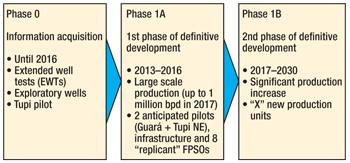 |
|
Fig. 3. PLANSAL phased development strategy.
|
|
Phase 1 is dedicated to definitive production systems installation and is subdivided into two sub-phases. Phase 1A aims to exceed production of 1 million bopd operated by Petrobras in 2017, using consolidated or rapidly consolidating technologies from the Campos Basin adapted to Santos Basin conditions. These are two anticipated pilots (in Guará and Tupi Northeast) and eight production systems (which share the same engineering project) and will be installed to generate cash flow for the subsequent projects, getting the benefit of flexibility provided by the combination of subsea completions, flexible flowlines and FPSOs. Phase 1B will complement the definitive development and begin in 2017. Further production systems will be required for the optimal exploitation of the fields using new technology solutions specially developed for the conditions of the Santos Basin pre-salt cluster.
To ensure that all needed capabilities were in place to design and execute the integrated planning, the PLANSAL program was structured in subprograms and functional plans, Fig. 4. The subprograms cover the company’s entire value chain and are held responsible for asset construction and planning of appraisal drilling, well tests, production units, logistics facilities to enable cargo and passengers’ transportation, storage and all infrastructures for oil and gas evacuation that will allow the Santos Basin pre-salt cluster development and operation. The main disciplines that support several of these subprograms, and are responsible for designing strategies to deliver all resources needed to the projects in a timely manner, are: critical equipment, environmental licensing, operational safety procedures and emergency plans, skilled professionals, and others.
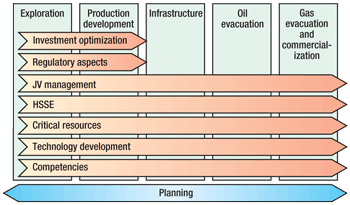 |
|
Fig. 4. PLANSAL structure: subprograms and functional plans.
|
|
All these entities working together in tight integration ensure that the most updated feedback coming from project execution is incorporated as input whenever necessary, following the guidelines provided by the Pre-Salt Corporate Integration Committee, which is coordinated by the executive managers of Corporate Strategy/Performance as well as E&P pre-salt departments within the company.
The central concept of PLANSAL is intensive communication and collaboration, as it concentrates the work of hundreds of people and several disciplines, under a cross-function coordinating structure, to seek focus toward the same objective. To support it, a governance model was defined to integrate planning and execution, and also to preserve the links between Petrobras’ corporate processes and project approval activities of each consortium.
The decision-making events of the PLANSAL governance model (Fig. 5) are called “HoAs,” after heads of agreement, as they represent the commitment each group has in relation to the results of the program. Each governance level has its defined objective and agenda: HoA Levels 4 and 3 are those where project execution is monitored and the feedback to strategy starts; HoA Levels 2 and 1 have the main focus to discuss strategy and planning, with highlights of projects’ status whenever needed. And as a final point, HoA Level 0 marks the delivery of the most updated version of the master plan to the company’s executive board.
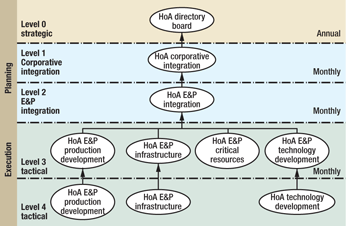 |
|
Fig. 5. PLANSAL governance model.
|
|
Those meetings allow the relevant information to be diffused in a timely manner among all hierarchical levels of the organization in a structured process, and the decision-making process to occur in the proper level of the organization.
AGGRESSIVE STRATEGIES
This collaborative and integrated environment provides an overview of all projects and commits all company stakeholders. Such an approach led to the understanding that the low exploratory risk of the area, coupled with the high potential reservoirs and high reserves estimated, allowed the adoption of an aggressive and innovative development strategy. Anticipation of commercial production is one of the drivers of this strategy, which includes contracts for batch production units with accelerated delivery. The so-called “FPSO factory” is just one realistic example of initiative never experienced in the Brazilian oil and gas industry.
Also to anticipate production, most drilling activities would start much earlier than the expected first-oil date of a specific production unit. Considering that, on average, each of the first 11 production systems (Phases 0 and 1A) could have about 20 wells, there could be more than 200 wells drilled in the next few years—a big challenge considering that drilling rigs are the most critical and expensive equipment in the industry. Consequently, a bold strategy had to be designed to assure that Petrobras will have all rigs in place in the timeframe needed. For that matter, the company had already contracted 26 ultra-deepwater rigs in the last few years, and a bid process is ongoing to acquire up to 28 more newbuilds.
Both the FPSO factory approach and drilling rigs acquisition, among others, are strategies that will also improve local content by providing scale to promote Brazilian industry expansion in competitive terms. This will be accomplished by expanding capacity of already existent suppliers, creating new local players through the installation of foreign suppliers in Brazil and establishing partnerships with local companies.
As previously mentioned, the pre-salt’s combination of positive characteristics is allowing Petrobras and its partners to adopt aggressive strategies to accelerate the acquisition of information and the definitive development of the area. One of the most emblematic efforts being made to implement it, in accordance with Petrobras’ policy of developing competitive domestic production of goods and services, is the construction of eight FPSOs known as “replicants” for sharing the same engineering projects. This solution provides the scale needed to ensure the competitiveness of local production with reduction of the average time of construction for the first units. It also supports the rapid ramp-up of the cluster oil output. The combined schedule of the area appraisal with this FPSO factory will permit reduction of the time from the end of the exploratory appraisal phase to first oil by an average of 54%.
Traditionally, major offshore production project implementation considers six months for the basic studies of a field, with another semester for concept selection, around one year of detailed engineering design and up to four additional years for execution before the project is completely implemented, totalling 72 months. According to PLANSAL, anticipating the engineering and construction in batches of highly flexible standardized FPSOs in parallel with the appraisal will lead to an average delay of 33 months between the end of delimitation and production startup.
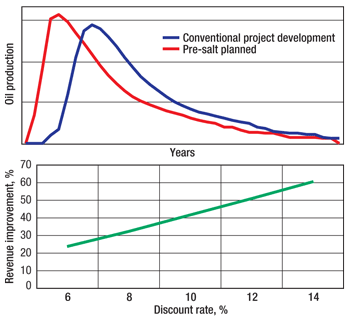 |
|
Fig. 6. Oil production and revenue improvement of pre-salt.
|
|
Figure 6 shows the gains in production with a higher and earlier production peak and in revenue, in terms of present value, depending on the discount rate. Taking a 10% discount rate as an example, the strategy of production acceleration improves the present value of the revenue by more than 40%. The quantification of benefits and risks of some of these strategies was the drive for the Petrobras executive board’s decision to make continued investments in pre-salt development even during the global financial crisis of 2008–2009. 
|
THE AUTHORS
|
|
Jose Formigli is the Executive Manager of Petrobras E&P-Presal, Coordinator of the Master Plan for Santos Basin’s Pre-Salt Cluster Development (PLANSAL) and Executive Manager of Petrobras’ strategy. He has 27 years of professional experience within Petrobras, where he also served as Production Manager of the Campos Basin, Asset Manager of Marlim Field, Executive Manager of E&P Services and Executive Manager of E&P Production Engineering. Mr. Formigli has a degree in civil engineering and is specialized in petroleum engineering.
|
|
|
| Mauro Yuji Hayashi is the Planning Manager of Petrobras E&P-Presal, responsible for coordinating the elaboration of PLANSAL. He has a degree in mechanical engineering from the Federal University of Paraná, Brazil, and is specialized in petroleum and reservoir engineering, business management and risk management. He has 25 years of professional experience within Petrobras. |
|
|
| Fernando Mendes is an Industrial Engineer working within Petrobras E&P-Presal to manage the Santos Basin Pre-Salt portfolio, including long-term production, resource demand planning and economic and financial evaluation. Mr. Mendes has a degree in industrial engineering from the Federal University of Rio de Janeiro, Brazil, and is specialized in upstream. |
|
|
| Mariana Muniz is a Consultant of Petrobras E&P-Presal Planning supporting PLANSAL coordination. Ms. Muniz has a degree in industrial engineering from the Federal Center of Technological Education, Brazil, and is specialized in project management. She has four years of professional experience within Petrobras. |
|
|
| Michèlle Sampaio is Senior Manager of Deloitte Consulting, responsible for Petrobras Upstream. She leads Deloitte’s multidisciplinary team in support of planning, joint venture management and production development projects. Mrs. Sampaio has a degree in systems analysis from the Catholic University of Rio de Janeiro, Brazil, and is specialized in software process improvement and strategic management. |
|









